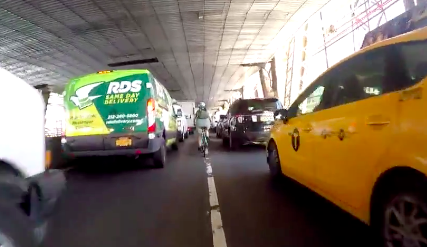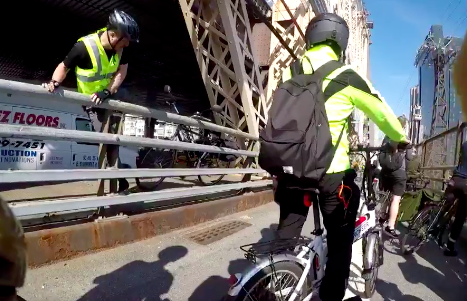“We felt we were being unlawfully detained — and unjustly because it was about our mode of transport.”
So said Laura Shepard, bike commuter, longtime Queens safe-cycling organizer and, since February, communications co-ordinator for Bike New York.
Shepard was among the dozens of cyclists whom NYPD blockaded on the Queensboro Bridge’s bike path from around 8:45 to a little after 9 a.m. on Friday, on the premise that their presence compromised the safety of the presidential motorcade on the FDR Drive below. The hastily installed blockade covered the outer roadway only; adjacent car and truck traffic was unimpeded.
Neither the NYPD or city DOT gave prior announcement of the blockade, so Shepard and other cyclists live-tweeted it from the roadway as a heads-up to other Manhattan-bound bike commuters.
During the detention time, a dozen or more cyclists hoisted their bikes over the guardrail to cycle amidst the cars and trucks on the bridge’s primary lanes. Handlebar footage of their speedy descents posted on Twitter was exhilarating, or unsettling, or both, although motor traffic was moving slowly, according to Shepard, under 20 mph and more often just 5-10 mph.
“The cop who stopped us said the wait could be as long as 45 minutes,” Shepard said, which surely motivated some of the intrepid hoisters. “I didn’t join them because of concerns for my safety, and I knew I wouldn’t be penalized at work. Plus, I figured I would use the time to do what the city didn’t do — warn others.”
In all my QBB crossings over the years, I’ve never even noticed the FDR below. I’m too pre-occupied with maintaining my pace on the uphill and managing my speed on the downhill. And if I look up from the path it’s to take in the spectacle of NYC from this fabulous vantage point, not to conjure a way to terrorize motorists underneath.
And while in theory it’s possible for a cyclist or pedestrian to haul a brick and drop it over the side, so could anyone in a car, cab or truck: just stop the vehicle, get out, climb over the low barrier, and let fly.

“It’s a twisted logic — the absurdity of stopping peds and cyclists but not drivers,” Shepard told me. “And the air quality was terrible with the slow-moving trucks, and no bathrooms or water. It’s a bridge, after all.”
Friday’s bridge blockage wasn’t the first use of extreme measures in the name of presidential security. In 2010, citing unnamed reports that parked bikes could house pipe bombs, the NYPD broke the locks of hundreds of bicycles chained to street furniture on East Houston Street, along the route of a motorcade carrying then-President Barack Obama, and carted them off in flatbed trucks.
What happened last Friday wasn’t as vicious. But if anything it’s more troubling. One sudden move by a car or truck driver could have caused injury or worse to one of the hoisters. And while it’s easy to say they should have just sat tight, I’m not sure I’d have waited in the face of a possible 45-minute hold.
In Iowa and elsewhere, de Blasio is casting himself as the anti-Trump. We city cyclists and pedestrians know that when our rights — and safety — are at stake, the two of them are pretty much one and the same.






